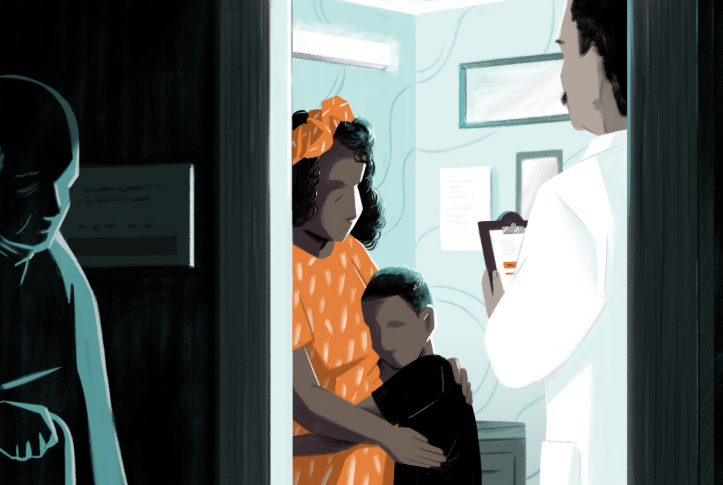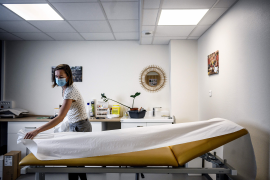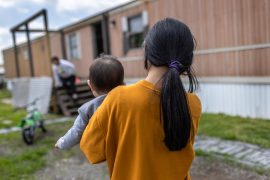What is it like for people living in poverty to take the afternoon off to go see a doctor?
Not only do they forgo badly needed wages, but often they must also find someone to watch their children and then scramble to catch a ride or come up with bus fare – only to spend five minutes with the doctor and leave with a prescription that doesn’t address their most pressing concerns.
The Commonwealth Fund’s Shanoor Seervai and Corinne Lewis listened to stories like this from more than 100 low-income patients and the primary care providers who serve them.
On this episode of The Dose, they discuss what they learned about the time constraints and financial barriers that can make it an ordeal for people living in poverty to seek even the most routine health care.
Transcript
CORINNE LEWIS: For people living in poverty, going to the doctor can be a huge ordeal and an incredibly stressful experience. One patient that comes to mind had to call out from her — from her job that day. So she, that day, did not make any money that she normally would have, because she didn’t have paid time off from work. She then had to arrange for child care, which was incredibly expensive and something that she didn’t have planned in her weekly budget.
And then once she actually got to the doctor, she waited in the waiting room for 30 minutes just to see the doctor. And then once she finally walked into the office, the doctor spent five minutes with her. And she didn’t get all of her concerns addressed, and she felt like she was being rushed out the door.
It left her feeling like, “Why did I take all this time off work, and spend money on child care, just to go and spend five minutes with a physician?”
She then told us that she wanted to talk about her mental health concerns, and when she did the physician actually said to her: “Well, here, I’ll write you a prescription.” And she was like, “You’re actually not hearing me or speaking to me. I can’t take these prescriptions, because I also am sober, and I’m not able to take these medications.”
[Music plays.]
SHANOOR SEERVAI: Hi, everyone. Welcome to The Dose. That was my coworker, Corinne Lewis, who does research here at the Commonwealth Fund about how to make the health care delivery system work better for the people who are actually using it. So, Corinne just told us a story about one person who’s living in poverty, and what it was like for her when she went to see her doctor.
But we actually heard a version of this story over and over again in focus groups with more than a hundred low-income patients. And basically, all of them said they don’t feel as if their doctors have enough time for them.
Corinne, thanks for joining me on the show.
CORINNE LEWIS: It’s great to be here.
SHANOOR SEERVAI: So, Corinne and I have been working on this project for about a year and a half now, on really trying to tell stories through the voices of patients themselves, what it’s like to be living in poverty, what it’s like when they got sick, how they’re trying to stay healthy.
CORINNE LEWIS: I can’t believe it’s been that long. I think because the interviews with patients surfaced so many different things and issues — so we talked about, you know, time, the costs of just going to the doctor. Mental health issues. Stress. It just feels like there’s so much more that we can say on the subject.
And then we also did focus groups, too, with primary care providers who work with people living in poverty. But we can talk more about that later.
SHANOOR SEERVAI: Where do people get insurance if they are low income and don’t probably have jobs that provide it?
CORINNE LEWIS: So, the Medicaid program is the main provider of insurance for low-income people. So for people that are at 138 percent of the federal poverty level — so what that actually translates to is around $29,000 a year for a family of three —
SHANOOR SEERVAI: That’s not a lot of money.
CORINNE LEWIS: Not a lot of money at all. And that’s in states that did expand Medicaid. In states that did not expand Medicaid, it’s even less. So, it turns out to be $175 a week for a family of three.
SHANOOR SEERVAI: I mean, if you think about it, $175 is actually what groceries cost for a family for a week. And so if that’s how little money you have to be making to get Medicaid, you’re basically only able to cover your food. That doesn’t even take into account rent, utilities, or all the other costs of just trying to make ends meet.
CORINNE LEWIS: Uh-huh. Exactly.
Some people have the option to buy insurance on the marketplaces, but that is often really, really expensive.
SHANOOR SEERVAI: Aren’t there ways for people to get subsidies to buy insurance on the marketplaces? The Obamacare marketplaces?
CORINNE LEWIS: Yes, there are subsidies. But even with the subsidies, health — buying health insurance in the individual market is really, really expensive and can be really difficult for low-income people.
SHANOOR SEERVAI: And what does that mean for taking their medications?
CORINNE LEWIS: Yeah. So, that’s a huge issue. I remember hearing from — from patients in the focus groups that, you know, one person said one of their medications for one month — one bottle that lasted them one month — was $1,500. And he was like, “I can’t afford that. I just simply can’t. So I just — I don’t take that medication.”
SHANOOR SEERVAI: Let’s just back out of things a little bit. Why are we focusing on low-income patients?
CORINNE LEWIS: We were really interested in looking at low-income people, because there are huge health disparities in this country by income. So, there’s research by Raj Chetty, an economist, that shows that the top 1 percent of Americans, at this point, are expected to live 10 to 15 years longer than the bottom 1 percent of Americans. And what’s really, really shocking about this problem is that low-income people are much more likely to have health problems. But they also are much more likely to have poor access and poor quality of care.
So we wanted to, thinking about this problem, hear from the people directly impacted by it. I think often times in health policy work, the people that are really affected by the problems aren’t always at the table. So we wanted to really, you know, get them at a table and hear from them in their words — what would fix health care in this country for you?
SHANOOR SEERVAI: And so in going through this, and actually trying to listen to what people had to say — what’s something that stood out to you?
CORINNE LEWIS: I think the thing that stood out to me the most is this issue of trust. So a lot of the low-income patients we spoke with told stories like the one that I just told. Often times they were people of color that felt discriminated against by their provider. They often felt they were treated differently because they were insured through the Medicaid program.
And then also, just this issue of, like, going to the doctor and having a five-minute visit. And I mean, I remember in my own life when I go to the primary care provider I have, like, a five-minute visit with the doctor. And they have a laptop up, and they’re like, plugging in all the information. And for low-income people, when they actually have, like, all these barriers to actually getting in the door — don’t really feel like going to the doctor is gonna solve their problem or make them healthy.
And I remember, you know, one patient told this story of when she was in the doctor’s office, the doctor said to her, like, “Oh, look at your history. You know, you had this substance abuse problem, and you’re diabetic because you’re overweight and you’re not eating healthy.” And she was like, “It was so rude, I just felt like completely — I felt judged.”
SHANOOR SEERVAI: Yeah. I want to pick up on what you said about it being rude. Because that’s — when I was looking over the transcripts of our interviews, and then I actually went back and recontacted some of these people to ask them in more detail about their experience. And what really struck me is that — and this should be obvious: People feel it when they’re being disrespected.
And I remember this woman said to me — she lives in a poor neighborhood in L.A. And she was like, “I — I can’t take my kids to play outside where we live. We have to go to a different neighborhood. Because where we live, there’s broken glass on the streets. There’s dirt everywhere. There are constant car break-ins. There are people doing drugs.” I remember this, because it stayed with me. She said, “It’s because we’re at the bottom of the totem pole.”
And this lack of dignity, it’s not something that we can, you know, put a pinpoint on and say, “Well, this is the problem with the health system.” It’s just about how you treat people.
CORINNE LEWIS: Absolutely.
SHANOOR SEERVAI: Another thing that came up — and you raised it — is this issue of being discriminated against. We actually had a listener write in after one of our recent episodes of The Dose. And he said that he’s biracial, and he feels most comfortable when his provider is a person of color.
CORINNE LEWIS: It’s interesting that you got that e-mail from a listener. Because there’s actually research to support that. People of color often feel they have higher quality of care and are more satisfied with their care if their doctor is of color. I think that’s — it’s a huge issue. And, you know, when you have an experience with a provider and you feel like you’re being discriminated against because you’re a person of color, like — that relationship is immediately broken.
And I think there’s been a historical distrust, among people of color, with the health care system.
SHANOOR SEERVAI: And so that’s the experience in the health care system. And we should definitely talk about this today. Because a lot of the — a lot of people’s health is related to stuff that happens outside the doctor’s clinic. And I’m thinking specifically of this woman I interviewed who lives in Queens. And her son works as a carpenter.
She said he has odd hours. So he’s like, you know, moving around late at night with a bag of tools. And he’s regularly stopped by the police in his neighborhood. He’s never gotten a speeding ticket. There’s never been a traffic violation. But she said to me, she said, “From the time that he leaves until he comes home, I can’t breathe.”
This is a black woman. So we know that people of color — and particularly African Americans — have a very deep-rooted fear of law enforcement. That kind of stress — like, that takes a huge toll on your body. And that doesn’t necessarily have — like, your doctor can’t fix it, right?
CORINNE LEWIS: Uh-huh. Stress really can have a huge impact on your physical health, of course, but also your mental health. And what I think was really striking to me is that a lot of the people living in poverty that we spoke with in the focus groups talked about this issue of — “There’s really, really widespread mental health issues in my community, but there also is this stigma, and we’re not talking about it. And we’re not talking to our doctors about it.”
SHANOOR SEERVAI: So, your mental health concerns are probably made worse by the stresses that you have to live with. What are some of the stresses that people living in poverty experience? What came up?
CORINNE LEWIS: Getting by, I think is the first and foremost concern they have. Living paycheck to paycheck, being able to afford their housing. Being able to find and afford healthy, nutritious food for themselves and for their children. Being able to, you know, just pay everyday bills and save up for rainy days and all of that.
SHANOOR SEERVAI: So let’s talk now about what the doctors we interviewed said. What’s their experience off caring for people who are dealing with all these stresses of just getting by?
CORINNE LEWIS: Yeah. So, we — after doing the focus groups with low-income patients — we realized we really needed to go and talk to primary care providers. People that have a primary care provider, that’s the person you’re seeing for a really long period of time. It’s supposed to be this continuous, comprehensive, coordinated care.
So, we did focus groups with primary care physicians that were practicing in communities that had a lot of low-income patients.
And what we heard was — this issue of time. Which, you know, completely mapped with what we heard from low-income patients. That, you know, “My doctor’s in for five minutes and then out the door.” Doctors know that. And they were really, really upset about it. Because these people are — you know, went into primary care because they wanted to spend time with patients. Primary care is traditionally the practice in medicine where you really get to know people. You know. You’re out at the grocery store on Sunday, and you see your patients. You’re part of the community. So they felt really, really torn up, honestly, about the fact that they have these financial pressures that they have to spend five minutes with a patient.
SHANOOR SEERVAI: What are the financial pressures that these doctors have, making it so that they’re only spending five minutes with their patients?
CORINNE LEWIS: So, primary care providers are typically reimbursed or paid by insurers per visit. So every time they see a patient, they get a payment. Also, in — when you’re seeing a lot of low-income patients that are typically covered by Medicaid or they’re paying out of pocket on some sort of sliding scale, they — those payments tend to be — tend to be lower.
SHANOOR SEERVAI: Okay.
CORINNE LEWIS: So Medicaid reimbursement for primary care is lower than, say, a private insurer would pay. Also, over time, Medicaid reimbursement for primary care has actually gone down. So primary care providers that are seeing a lot of low-income patients really, just to make ends meet and to make their bottom line, they need to see a lot more and more patients.
SHANOOR SEERVAI: How do they get around this problem?
CORINNE LEWIS: Yeah. So, a lot of the providers we talked to said that they are on call pretty much 24/7.
SHANOOR SEERVAI: Wow.
CORINNE LEWIS: So they give their patients — this is especially true in rural communities, I found, because they’re — in terms of primary care providers in that community, they’re it. You know, there’s no one else around. It’s them or the hospital. So they actually talked about giving patients their cell phone number.
And I remember one doctor said, you know, “That’s been the most effective way of keeping patients out of the emergency room. Is just giving them my cell phone and saying, “Call me any time.” Yeah.
SHANOOR SEERVAI: Issues shouldn’t escalate to the level of an emergency anyway, right? Ideally, you should be able to be seeing your doctor regularly, where your little cough doesn’t turn into a 105-degree fever and then you have to go to the emergency room.
CORINNE LEWIS: Right. Low-income people that aren’t going to the doctor, either because they can’t afford it, or they’re worried about getting some sort of surprise medical bill, or they don’t trust going to the primary care doctor — often then just wait ‘til the health issue they have has escalated to the point that they need to go to the emergency room.
So a lot of people, especially uninsured people, the place they go to get care is the emergency room. Which is a huge problem, and leads to higher costs in the health care system. So primary care is really important for preventing those kinds of events and making sure people are healthy and don’t get to that point where they need to go to the emergency department.
SHANOOR SEERVAI: Let’s talk about doctors in rural communities. ‘Cause I interviewed a couple of them as well. And one of them who’s out in a small town in Arizona, and she serves a bunch of people living in poverty in this town, but she also serves people who live on a Native American reserve that’s about an hour away. And she says that these people travel an hour each way just to get to her. But because she’s the only primary care doctor in that region, they do it.
CORINNE LEWIS: What was interesting hearing from the providers especially, is that they know transportation is a huge issue for their patients. But they just don’t know how to fix it. They don’t know what they can do beyond, you know, like, “Here’s my cell phone number, and call me, and we can try to talk through this.”
SHANOOR SEERVAI: One of the providers I spoke to said that sometimes she’ll give her patients 20 bucks for — if they say, “We can’t afford gas money,” she’ll just give them 20 bucks. But that is not sustainable at all.
CORINNE LEWIS: Yeah. No, that’s incredible, but definitely not a systematic solution.
SHANOOR SEERVAI: What are some of the solutions that we can begin to point to, now that we have the perspective both of the people who are using the health system, and their doctors?
CORINNE LEWIS: Uh-huh. So, I think Medicaid has a huge role to play in solving some of these problems. So the obvious thing is, you know, Medicaid could reimburse more for primary care. That would mean that providers have a little bit of flexibility to spend some more time with their patients, rather than, you know, seeing more and more and more patients.
I think the other thing is, providers need to just treat people with respect. Recognize that this is an issue that low-income patients are feeling this way, and try to communicate better with their patients.
SHANOOR SEERVAI: I feel like that is easier said than done.
CORINNE LEWIS: It is — it is easier said than done. But there are, I think, ways that — at least education could be improved, and training could be improved.
SHANOOR SEERVAI: So, two doctors who I had on The Dose a few weeks ago were talking about the things that they learn in medical school, and then the things that they don’t learn in medical school. And one of them brought up the issue about costs. And she said, “You know, we weren’t really trained to talk to our patients about costs. And it’s something that observing repeatedly what a sense of stigma my patients feel when they go to fill a prescription and they realize that they can’t afford it.”
So now what she does is, she tries to bring it up, up front.
CORINNE LEWIS: Absolutely. I think that would be really, really helpful, if providers were more transparent about costs, and felt comfortable just talking to patients about that. But I would even say — cost itself for low-income people in the health care system is a huge problem. It shouldn’t be that a patient can’t fill their medication because they can’t afford it.
So reducing out-of-pocket costs, deductibles, for low-income patients, I think is really important. And expanding access to affordable coverage, so people, you know, have the resources to get the care they need, is really important too.
Medicaid expansion in the states that have not expanded yet would certainly help the low-income people living in those states that right now just simply can’t afford health care.
SHANOOR SEERVAI: If we come back to that first story you told me. We had a person who was worried about her mental health. She went in to see her doctor. She felt like she wasn’t being heard, and she got a prescription that she couldn’t fill, and ended up paying somebody to look after her child.
As has come up repeatedly in this conversation, that just sounds like the worst possible experience you could have going to see your doctor. What have we learned about how that experience could be different?
CORINNE LEWIS: I think the bottom line is, people living in poverty want and need better care. And their doctors really want to help solve these problems, too. They don’t want their patients to be unable to afford care, or to not trust them and feel like the doctor’s office is a place to go when you’re feeling sick.
So being able to talk to people directly, and hearing from patients and providers, showed me that it’s really important to involve the people directly impacted by your work, in your work. And that patients and providers really need to start talking to each other and need to be talking to us, too, as people involved in policy discussions.
[Music plays.]
SHANOOR SEERVAI: When we started making this podcast, we wanted to give new ways of thinking about some of the complicated issues in health care. Are we doing that? Let us know what you think. Leave us a review on iTunes or your favorite podcast app.
Are there topics in health care you want to know more about? Send us an email. Our address is [email protected].
|
Want to know more about how primary care improves health? Evidence shows that primary care helps prevent illness and death, and that primary care (in contrast to specialty care) is associated with a more equitable distribution of health in populations. Read more here. |




